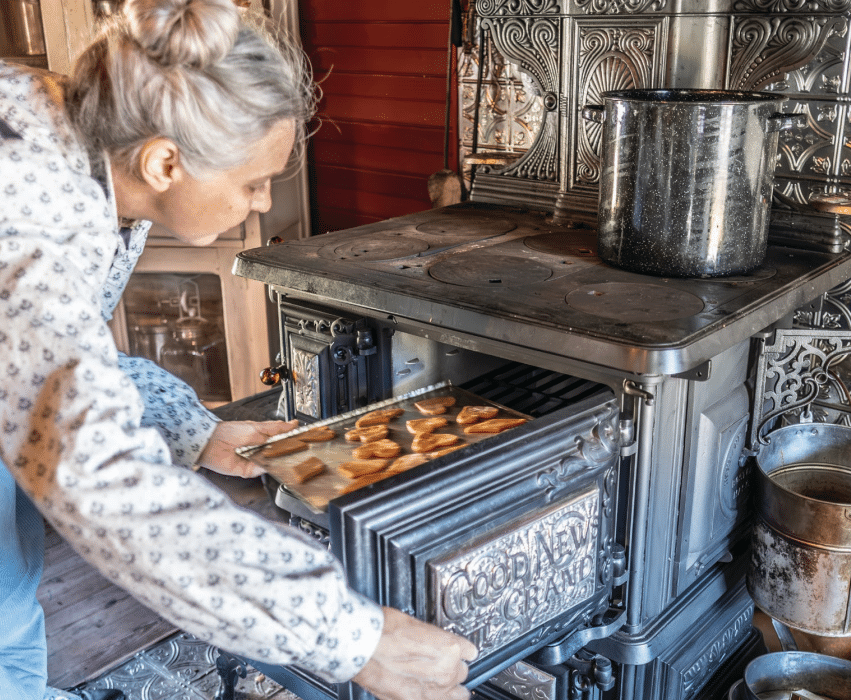
Grapevine’s historic Nash Farm cooks and bakes a mess during the holidays, and visitors can join the fun
By Joy Donovan
Photos by Olaf Growald
The aroma might precede the sight of Christmas cookies at Grapevine’s historic Nash Farm. The taste will follow. But it’s the memories of another time that will linger long after the last cookie is consumed. That’s exactly the point, according to Kimberly Wageman-Prack, Nash Farm coordinator. Immersing the senses, sparking family conversations and learning history is what she wants people to take away from a visit to the city-owned site.
“We don’t smell like a museum,” she said, sitting in the home with the windows wide open and the wind wafting through. She creates many of the working farm’s public programs in a way to immerse the senses.
“We believe in our programs being a family experience, because we want the family to build fantastic memories,” she said. “It makes history a positive experience, a family history instead of it being something you have to suffer through in school.”
Nash Farm, at 626 Ball St., sits on 5.2 acres of the original farm owned by Elizabeth and Thomas Nash. Even though it’s now surrounded by busy streets, popular restaurants and prosperous retailers, the original home, built in 1869, now serves as a living example of life in the late 1800s. With livestock and period dress for families to view, the working farm is managed by the Grapevine Heritage Foundation. The public gets to see, touch and smell livestock, and interact with historical interpreters.
Wageman-Prack’s career in historical interpretation started with a fifth-grade dare. A classmate bet her she wouldn’t be able to volunteer at Bent’s Old Fort, a National Historic Site in Colorado. Not only did she manage to become a volunteer as a fifth grader, but she became a park ranger there as an adult. She has worked at museums throughout the country, studying, researching and recreating history every day.
Giving Nash Farm visitors an experience as authentic as possible is important to her. Visitors wandering through the historic farmhouse and grounds can’t predict what they’ll see. Maybe Wageman-Prack will tuck a chicken under her arm to allow school children a chance to see it or maybe she’ll cook an authentic culinary creation.
“You can come in and walk through the house,” she said, gesturing toward period furniture. “You can experience the farm, the roosters crowing and the chickens walking around. You can experience history instead of just hearing about it. If we make history boring, people just walk away. If you make a connection, their world is expanded.”
”Wageman-Prack’s life work has been to embody history, making it relevant to today’s world. Through her research, she brings to life the Nash family’s lifestyle from another century, daily sharing knowledge to the farm’s visitors from around the world.
“Kimberly lives and breathes the lifestyle of Mrs. Nash from the 1870s at the living history Nash Farm,” said Paul McCallum, executive director of the Grapevine Convention & Visitors Bureau.
“Dressed in period clothing, she builds a fire in the 19th century wood cook stove and begins to mix the flour, roll out the dough and soon is baking the most wonderful Victorian Christmas treats you can imagine. She is the living history educator of life on the Grapevine prairie in the 1870s.”
Most days, her work clothes are “historic clothing” or “period dress.” She sews a lot of it to make it historically accurate. “I wear the whole shebang,” she said. “The chemise, the corset, the whole thing.” Nash Farm marks seasons and holidays throughout the year. This year, holiday decorations go up and activities start Nov. 25.
Old-fashioned cookies will be baked on an antique wood-burning stove Dec. 3, 8, 10, 15, 16, 17 and 23. Other foods will be cooked in demonstrations, 3-6 p.m., Dec. 2, and 1-4 p.m. Dec. 9.
On cookie baking days, for $3 per person, visitors can make molasses cookies with Wageman-Prack, who has extensively researched the recipes and baking techniques from the late 1880s. “Cookies would have been a treat,” she said. These will look like gingerbread and taste like cloves. “Most people aren’t used to eating cloves any more, but it’s definitely a Christmas taste and smell.” Then 1-4 p.m. Dec. 9, Wageman-Prack has planned “A Farmstead.
“We believe in our programs being a family experience, because we want the family to build fantastic memories.”
Christmas,” a public open house with ornament making, gift wrapping and food preparation. “Believe it or not, the big thing for the holidays was oysters,” she said. Oyster stew would also join such dishes as ham, turkey, corn, potatoes, green beans, black-eyed peas and sweet potato biscuits. “Food connects everybody,” she said. “I find it very interesting that cooking here and talking about this, generally people find something they can relate to.”
In her work at the farm, WagemanPrack has created entire meals served to Sister Cities International visitors and other dignitaries to give them an idea of what the Grape Vine Prairie and the South were like more than a century ago.
Previous dinners she conceived are documented in cookbook brochures available at the farm’s gift shop and include locally sourced bread and butter, pickles she canned herself, potted cheeses infused with fresh herbs and smoked turkey, pasture-raised on the farm.
“We want people to realize if it weren’t for all the farmers who did what they did,” she said, “Grapevine wouldn’t be what it is today.”
